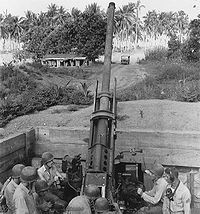- Marine defense battalions
-
Marine defense battalions were United States Marine Corps battalions charged with coastal defense of various naval bases in the Pacific during World War II. They maintained large anti-ship guns, anti-aircraft guns, searchlights, and small arms to repel landing forces.
Contents
Organization
Unlike the mobile Marine forces involved in offensive actions, defense battalions were detached to key outposts, in the Pacific and one in Iceland,[1] and remained at the station they defended.[2] Most varied greatly in size and equipment. The battalions often had several coastal gun batteries, several anti-aircraft batteries, a detection battery (searchlights and radar), and machine gun units. While a few had composite infantry companies attached, most defense battalions were responsible for providing their own riflemen.
History
For more information, see Advanced Base Force.The defense battalions were first conceived from the fixed defense concept during the Marine Corps's, as well the United States Navy's, critical change in their traditional sea service role to a more 'aggressive' amphibious landing force. They conducted "fixed" defense exercises on Culebra Island of Puerto Rico throughout the first half of the 20th century, and other areas around the Caribbean.
The first battalions were created in 1939, when the outbreak of World War II caused concerns that overseas bases might be attacked by the Imperial Japanese Navy.[2] After the attack on Pearl Harbor, where defenders shot down three planes on December 7, 1941, the battalions grew rapidly. On December 8, the Japanese began an assault on Wake Island, and the defenders surrendered after a prolonged battle on December 23.[3]
1942 became a period of defense for the Pacific Theater, and as such, the Marine Defense battalions saw much reinforcement, redeployment, and growth. On June 4, the Marines at Midway Island fended off a Japanese aerial attack, which contributed to the victory of the naval battle hundreds of miles away. On August 7, the 3rd Defense Battalion went ashore with the infantry to Guadalcanal and defended the island (and others in the Solomon Islands) against Japanese counterattacks during the Battle of Guadalcanal.
In the summer of 1943, elements of the 9th, 10th, and 11th Defense Battalions supported the Army's XIV Corps in the central Solomon's campaign. Other battalions helped clear the northern islands, including Bougainville, and by the spring of 1944, they were all taken.
In early 1944, the Marshall Islands became the next target in the Pacific, and the Marine defenders moved in. By summer, they landed in the Mariana Islands, including Saipan, and Guam. During that time, Commandant of the Marine Corps LtGen. Alexander Vandegrift began to scale back on defense battalions. Two were disbanded, and the remaining began to gradually focus on anti-aircraft defense, rather than coastal defense. Only the 6th, the 51st, and the 52nd remained designated as defense battalions, the rest had become anti-aircraft units under Fleet Marine Force, Pacific.
In late 1944, the 2nd, 5th, 8th, and 16th Antiaircraft Artillery (formerly Defense) Battalions formed the 1st Provisional Antiaircraft Artillery Group in preparation to invade the Japanese Home Islands. While they did not participate in the Battle of Iwo Jima, they did land on Okinawa in April 1945. Soon after, the Japanese surrender lead to the disbanding of most of the defense battalions.
Marine defense battalions were seen as an ideal platform for integrating African Americans into units with white leaders, since they trained independently and fought in isolated areas.[4] Those recruits slated for defense battalions were trained at the then-segregated Montford Point (now known as Camp Gilbert H. Johnson, part of the Marine Corps Base Camp Lejeune complex in North Carolina). They would then be assigned to the two black defense battalions, the 51st and 52nd.[4]
List of battalions
Insignia Battalion Name Nickname Location(s) 
1st Defense Battalion Wake Island Defenders Pearl Harbor, Hawaii
Wake Island
Johnston Island
Palmyra Island
Marshall Islands
Mariana Islands
Guam2nd Defense Battalion Hawaii
American Samoa
Tarawa
Guam
Okinawa3rd Defense Battalion Pearl Harbor, Hawaii
Midway Island
Guadalcanal
Tulagi
Bougainville4th Defense Battalion Guantanamo Bay, Cuba
Pearl Harbor, Hawaii
Midway Island
New Hebrides Islands
New Zealand
Guadalcanal
Vella Lavella
Peleliu
Okinawa5th Defense Battalion Iceland
New Caledonia
Tulagi
Ellice Islands
Hawaii
Okinawa6th Defense Battalion Hawaii
Midway Island7th Defense Battalion American Samoa
Upolu
Ellice Islands
Peleliu
Hawaii8th Defense Battalion American Samoa
Wallis Islands
Gilbert Islands
Hawaii
Okinawa9th Defense Battalion Fighting Ninth[5] Guantanamo Bay, Cuba
Guadalcanal
New Georgia
Arundel Island
Guam [6]10th Defense Battalion Russell Islands
New Georgia
Arundel Island
Marshall Islands11th Defense Battalion New Hebrides
Guadalcanal
Russell Islands
New Georgia
Arundel Island
Guadalcanal12th Defense Battalion Woodlark Island
New Britain
Russell Islands
Peleliu
13th Defense Battalion Guantanamo Bay, Cuba
Hawaii14th Defense Battalion Five: Fourteenth[5] Tulagi
St. Matthias Islands
Guadalcanal
Guam15th Defense Battalion First: Fifteenth[5] Marshall Islands
Mariana Islands16th Defense Battalion Johnston Island
Hawaii
Tinian
Okinawa17th Defense Battalion Two: Seventeen[5] Saipan
Tinian
18th Defense Battalion Saipan
Tinian
51st Defense Battalion Ellice Islands 
52nd Defense Battalion Mariana Islands
GuamSee also
Notes
- ^ Melson 1996, p.5.
- ^ a b Melson 1996, p.1.
- ^ Heinl, Jr., Lieutenant Colonel R.D. (1947). Marines in World War II Historical Monograph: The Defense of Wake. Headquarters, U.S. Marine Corps. LCCN 47046490. OCLC 2944549. http://www.ibiblio.net/hyperwar//USMC/USMC-M-Wake.html. Retrieved 2007-12-13.
- ^ a b Melson "Two African-American Defense Battalions" 1996, pp.8-9.
- ^ a b c d Rottman USMC WWII OOB, p.212.
- ^ Melson, Charles D. (c. 1990). 9th Marine Defense and AAA Battalion. Paducah, KY: Turner Publishing Company. ISBN 0-938921-85-0. LCCN 90070003. http://www.turnerpublishing.com/detail.aspx?ID=353.
References
- Melson, Major Charles D. (1996). Condition Red: Marine Defense Battalions in World War II. Marines in World War II Commemorative Series. Washington, D.C.: Marine Corps Historical Center. LCCN 96174419. OCLC 34920984. http://www.ibiblio.net/hyperwar//USMC/USMC-C-Defense/index.html. Retrieved 2007-12-12.
- Rottman, Gordon L. (2002). U.S. Marine Corps World War II Order of Battle - Ground and Air Units in the Pacific War, 1939 - 1945.’’. Greenwood Press. ISBN 0-313-31906-5.
External links
Categories:- Inactive units of the United States Marine Corps
Wikimedia Foundation. 2010.


